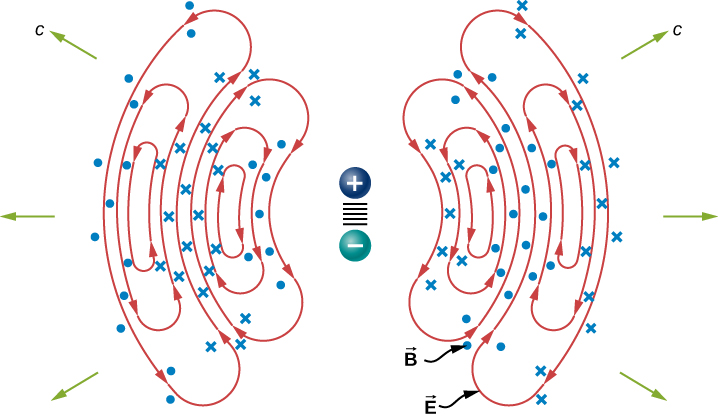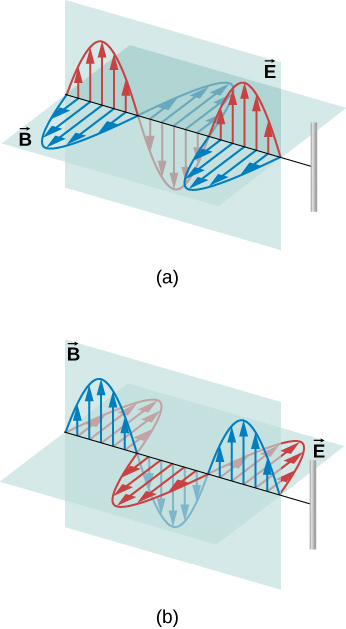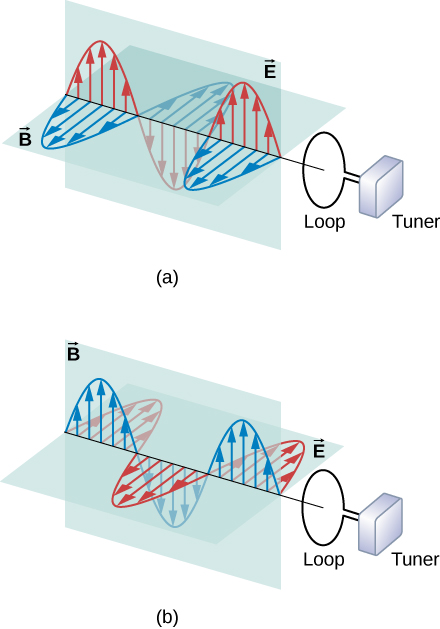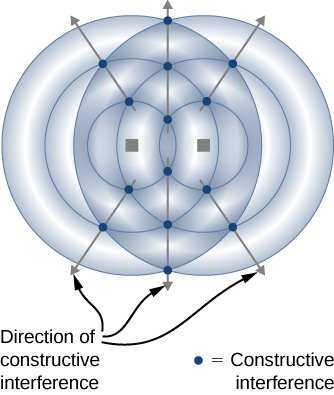| << Chapter < Page | Chapter >> Page > |

The electric field lines in one plane are shown. The magnetic field is perpendicular to this plane. This radiation field has cylindrical symmetry around the axis of the dipole. Field lines near the dipole are not shown. The pattern is not at all uniform in all directions. The strongest signal is in directions perpendicular to the axis of the antenna, which would be horizontal if the antenna is mounted vertically. There is zero intensity along the axis of the antenna. The fields detected far from the antenna are from the changing electric and magnetic fields inducing each other and traveling as electromagnetic waves. Far from the antenna, the wave fronts, or surfaces of equal phase for the electromagnetic wave, are almost spherical. Even farther from the antenna, the radiation propagates like electromagnetic plane waves.
The electromagnetic waves carry energy away from their source, similar to a sound wave carrying energy away from a standing wave on a guitar string. An antenna for receiving electromagnetic signals works in reverse. Incoming electromagnetic waves induce oscillating currents in the antenna, each at its own frequency. The radio receiver includes a tuner circuit, whose resonant frequency can be adjusted. The tuner responds strongly to the desired frequency but not others, allowing the user to tune to the desired broadcast. Electrical components amplify the signal formed by the moving electrons. The signal is then converted into an audio and/or video format.
Use this simulation to broadcast radio waves. Wiggle the transmitter electron manually or have it oscillate automatically. Display the field as a curve or vectors. The strip chart shows the electron positions at the transmitter and at the receiver.
If the electric field of an electromagnetic wave is oscillating along the z -axis and the magnetic field is oscillating along the x -axis, in what possible direction is the wave traveling?
In which situation shown below will the electromagnetic wave be more successful in inducing a current in the wire? Explain.

in (a), because the electric field is parallel to the wire, accelerating the electrons
In which situation shown below will the electromagnetic wave be more successful in inducing a current in the loop? Explain.

Under what conditions might wires in a circuit where the current flows in only one direction emit electromagnetic waves?
A steady current in a dc circuit will not produce electromagnetic waves. If the magnitude of the current varies while remaining in the same direction, the wires will emit electromagnetic waves, for example, if the current is turned on or off.
Shown below is the interference pattern of two radio antennas broadcasting the same signal. Explain how this is analogous to the interference pattern for sound produced by two speakers. Could this be used to make a directional antenna system that broadcasts preferentially in certain directions? Explain.

If the Sun suddenly turned off, we would not know it until its light stopped coming. How long would that be, given that the Sun is away?
499 s
What is the maximum electric field strength in an electromagnetic wave that has a maximum magnetic field strength of (about 10 times Earth’s magnetic field)?
An electromagnetic wave has a frequency of 12 MHz. What is its wavelength in vacuum?
25 m
If electric and magnetic field strengths vary sinusoidally in time at frequency 1.00 GHz, being zero at , then and . (a) When are the field strengths next equal to zero? (b) When do they reach their most negative value? (c) How much time is needed for them to complete one cycle?
The electric field of an electromagnetic wave traveling in vacuum is described by the following wave function:
where
k is the wavenumber in rad/m,
x is in m,
t is in s.
Find the following quantities:
(a) amplitude
(b) frequency
(c) wavelength
(d) the direction of the travel of the wave
(e) the associated magnetic field wave
a. 5.00 V/m; b.
; c. 31.4 cm; d. toward the +
x -axis;
e.
A plane electromagnetic wave of frequency 20 GHz moves in the positive y -axis direction such that its electric field is pointed along the z -axis. The amplitude of the electric field is 10 V/m. The start of time is chosen so that at , the electric field has a value 10 V/m at the origin. (a) Write the wave function that will describe the electric field wave. (b) Find the wave function that will describe the associated magnetic field wave.
The following represents an electromagnetic wave traveling in the direction of the positive
y -axis:
.
The wave is passing through a wide tube of circular cross-section of radius
R whose axis is along the
y -axis. Find the expression for the displacement current through the tube.

Notification Switch
Would you like to follow the 'University physics volume 2' conversation and receive update notifications?